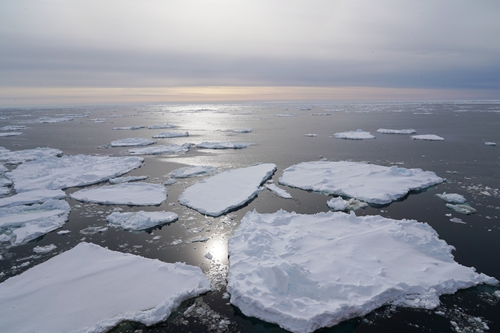
The melted ice in Cosmonauts Sea is taken aboard China's polar icebreaker Xuelong 2 in January. Photo: Courtesy of Liang Yingqi
A new study reported record low Antarctic sea-ice extent in February, showing for the first time the sea-ice extent in the Antarctic shrank to below 2 million square kilometers since 1978, the launch of satellite observations of the poles.
The study, conducted by a group of researchers at Sun Yat-sen University and Southern Marine Science and Engineering Guangdong Laboratory (Zhuhai) in China, identified the contribution of dynamic and thermodynamic processes to the record low sea-ice extent. Their findings were published in the journal Advances in Atmospheric Sciences on Tuesday.
The extent of sea ice in the Arctic is undergoing rapid decline as a result of global warming, but at the Earth's other pole, Antarctic sea ice has been enjoying a modestly increasing trend of about one percent a decade since the late 1970s.
But in 2017, the Southern hemisphere experienced a record minimum extent of sea ice. Then five years later, on February 25, a few days from the end of the Southern hemisphere's summer, scientists reported new record-low Antarctic sea ice extent of 1.9 million square kilometers.
Yang Qinghua, co-author of the study and climatologist at Sun Yat-sen University, told the Global Times on Tuesday that the Antarctic sea ice extent breaking the record again five years later may indicate that the Antarctic sea ice is experiencing extreme events more frequently.
The loss of Antarctic sea ice may affect the weather and climate in high latitude regions, accelerate the melting and disintegration of Antarctic ice shelves, raise sea levels and destroy the Southern Ocean ecosystem of penguins, seals, krill and whales.
However, Yang said that the current climate system models cannot well predict the exact future trend of Antarctic sea ice, and the record low sea ice extent might not necessarily indicate the Antarctic sea ice will witness a continued decline trend.
The researchers found that in the summertime, it is the thermodynamics that dominates the processes that cause the melting of the sea ice. This occurs through anomalies in the transport of heat toward the pole in the Bellingshausen/Amundsen Seas, the western Pacific Ocean, and the eastern Weddell Sea in particular. But in the spring, both thermodynamics and dynamics contribute to the status of sea ice extent.
In the study, scientists revealed how thermodynamics and dynamics affect the change of sea ice in the summer and spring of the Southern Hemisphere, providing a reference for further study and prediction of sea ice change in the Antarctic although the current preliminary study cannot systematically explain the sea ice change, Yang said.




